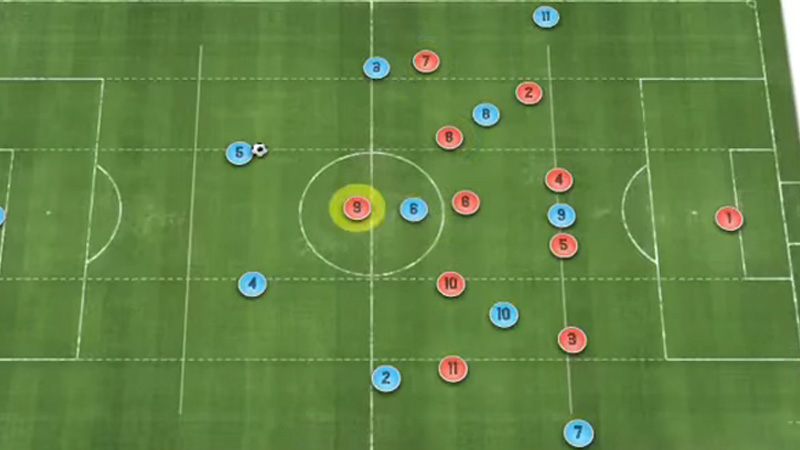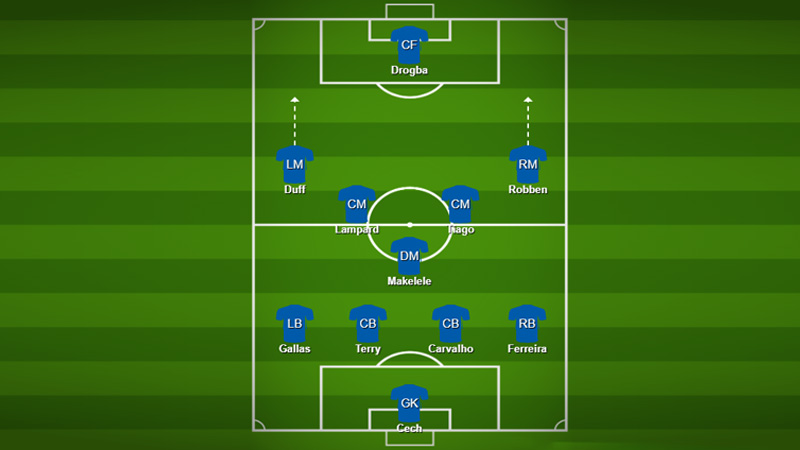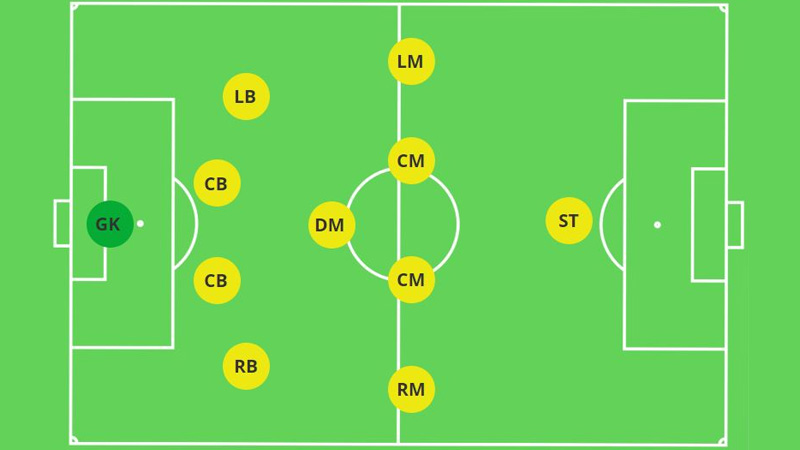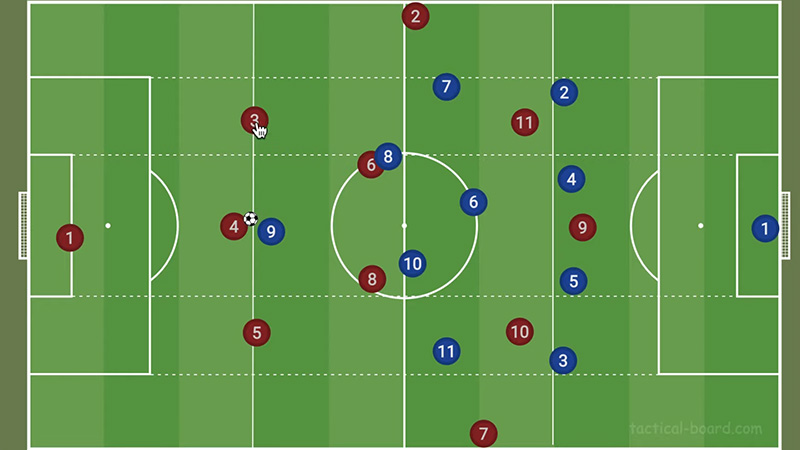The 4-5-1 soccer formation, also known as the 4-1-4-1 formation, is a tactical setup that has become a cornerstone in modern football.
Comprising four defenders, five midfielders, and one striker, this formation is designed to provide a balance between defensive solidity and attacking prowess.
With its emphasis on a compact midfield and solid defensive structure, the 4-5-1 formation allows teams to control the game’s tempo, dominate possession, and launch potent counterattacks.
The central defensive Midfielder acts as a shield in front of the backline, while the central attacking Midfielder supports the lone striker, creating a strong attacking presence.
This tactical approach has led to the formation’s widespread adoption by many top clubs and national teams worldwide.
What Is The 4-5-1 Soccer Formation?
The 4-5-1 soccer formation, also known as the 4-1-4-1 formation, is a tactical setup that consists of four defenders, five midfielders, and one striker.
This formation is designed to provide defensive stability by crowding the midfield and maintaining a solid defensive line while still having a central attacking presence.
It is often utilized by teams that aim to control the game’s tempo, dominate possession, and counterattack effectively.
Here’s a breakdown of each component of the 4-5-1 soccer formation:
Defenders (4):
The four defenders usually form a standard backline consisting of two central defenders and two full-backs.
Their primary role is to defend against the opposition’s attacks, win aerial duels, and clear the ball from dangerous areas.
The full-backs may also contribute to the team’s attacking play by providing width and overlapping the midfielders.
Defensive Midfielder (1):
The formation includes a single defensive midfielder who acts as a shield in front of the defensive line.
This player’s primary responsibility is to break up the opponent’s plays, intercept passes, and provide cover for the defenders. The defensive Midfielder plays a crucial role in protecting the backline and distributing the ball to initiate attacks.
Midfielders (4):
The five midfielders are usually deployed in two banks of four, with two central midfielders and two wide midfielders.
The central midfielders control the game’s flow, distribute the ball, and provide support to both defense and attack.
The wide midfielders, often known as wingers, stay wide to stretch the opponent’s defense, deliver crosses into the box, and track back defensively when needed.
Striker (1):
The lone striker is the focal point of the team’s attacking play. This player’s role is to hold up the ball, create space for the attacking midfielders, and capitalize on scoring opportunities.
The striker must have good positioning, link-up play, and finishing ability to be effective in this role.
Overall, the 4-5-1 soccer formation aims to maintain a compact and disciplined structure, especially in the midfield, while relying on the lone striker to lead the attack.
It is a versatile formation that can adapt to various match scenarios and is often employed by teams looking to remain defensively organized while still having attacking options.
How Do You Play A 4-5-1?

Playing a 4-5-1 soccer formation requires a well-coordinated approach to balance defensive solidity and attacking intent.
The formation’s strength lies in controlling the midfield and counterattacking effectively, making it a popular choice for teams looking to maintain shape while having a central attacking presence.
Here’s a breakdown of key aspects of playing a 4-5-1:
Defensive Organization:
In the 4-5-1 formation, defensive organization is paramount. The backline of four defenders and the defensive Midfielder work together to maintain a compact shape, limiting space for the opposition’s attackers.
Communication and discipline are crucial to ensure players stay in position and cover each other effectively.
Central Defensive Midfield Presence:
The lone defensive Midfielder is instrumental in protecting the defense. This player acts as a shield, intercepting passes, breaking up opposition attacks, and providing a safe outlet to start offensive transitions.
The defensive Midfielder’s ability to read the game and make timely interceptions is vital for thwarting opposing attacks.
Midfield Control and Possession:
With five midfielders, the 4-5-1 formation offers numerical superiority in the middle of the field. The central midfielders control the tempo, retain possession, and distribute the ball to initiate attacking moves.
Effective ball circulation and quick passing are key to controlling the game and tiring out the opposition.
Wide Midfielder Contributions:
The wide midfielders (wingers) play an essential role in stretching the opponent’s defense and providing attacking width. They need to be pacey and skilled in one-on-one situations to beat defenders and deliver accurate crosses into the box.
Additionally, the wide midfielders should track back to help the full-backs defensively, ensuring defensive balance.
Lone Striker Movement:
The lone striker’s movement is crucial in a 4-5-1 formation. They must hold up the ball effectively, involve the midfielders in the attack, and create space for supporting runners.
The striker’s ability to be an outlet for long balls and hold possession until support arrives is vital for initiating attacks and providing goal-scoring opportunities.
Quick and Effective Counterattacks:
The 4-5-1 formation allows for quick counterattacks due to its compact shape in midfield. The team can win the ball back in defensive areas and then swiftly transition into attack, utilizing the striker and midfielders’ pace and passing abilities to catch the opposition off guard.
Overall, playing a 4-5-1 formation requires disciplined defensive organization, dominant midfield control, effective contributions from wide midfielders, and intelligent movement from the lone striker.
It is a formation that requires the players to work as a cohesive unit to maximize its potential both defensively and offensively.
What Is The Strength Of The 4-5-1 Formation?

Source: jobsinfootball
The 4-5-1 soccer formation boasts several strengths that make it a popular choice for many teams.
Its emphasis on a compact midfield and solid defensive structure allows for effective control of the game and counterattacking opportunities.
Here are the key strengths of the 4-5-1 formation:
Midfield Dominance:
With five midfielders, the 4-5-1 formation offers numerical superiority in the central areas of the pitch. This allows the team to control possession, dictate the game’s tempo, and limit the opponent’s passing options.
The central midfielders can overload the midfield and create passing triangles, making it challenging for the opposition to regain possession.
Defensive Solidity:
The 4-5-1 formation provides a robust defensive setup with four defenders and a dedicated defensive midfielder.
The midfielders contribute to defensive duties, forming a compact block that restricts space and frustrates opponents.
The lone striker often drops back to support the midfield, adding an additional layer of defensive cover.
Effective Counterattacks:
The formation’s defensive organization allows for swift counterattacks. The team can quickly win the ball back in midfield or defensive areas and then launch fast and direct attacks, capitalizing on the pace of the wingers and the lone striker.
The central attacking presence helps connect the defense to the counterattacking players, making it a potent weapon against teams with a high defensive line.
Versatility:
The 4-5-1 formation offers tactical flexibility. The team can easily shift between a more defensive approach, sitting back and absorbing pressure, to a more attacking style, pushing the wide midfielders forward and supporting the striker.
This adaptability allows teams to tailor their game plan based on the match situation and the strengths of the opponents.
Controlled Transition Play:
The formation’s compact midfield and quick ball circulation facilitate controlled transition play. When transitioning from defense to attack, the midfielders provide passing options, enabling the team to progress up the field methodically and avoid being caught out of position.
The 4-5-1 formation’s strengths lie in its midfield dominance, defensive solidity, effective counterattacks, tactical versatility, and controlled transition play.
When executed well with players who understand their roles, this formation can be a formidable tactical setup, allowing teams to be competitive and versatile in various match scenarios.
What Is The Weakness Of The 4-5-1 Formation?

Source: themastermindsite
While the 4-5-1 formation possesses several strengths, it also has some inherent weaknesses that teams must be mindful of. Understanding these weaknesses is essential for coaches and players to devise strategies to address them effectively.
Here are the key weaknesses of the 4-5-1 formation:
Lack of Attacking Support:
With only one striker upfront, the 4-5-1 formation can sometimes lack sufficient attacking support.
The lone striker may become isolated and find it challenging to hold up the ball or create scoring opportunities without support from the midfielders. T
his can result in a limited number of players inside the opponent’s box during the attacking phases, reducing the effectiveness of penetrating through the defense.
Vulnerability on the Flanks:
The 4-5-1 formation’s compactness in the central midfield can leave the flanks exposed, especially if the wide midfielders do not track back diligently.
Skilled opponents may exploit this weakness by overloading the wings, delivering crosses into the box, or initiating attacks from wide areas.
Counterattacking Vulnerabilities:
While the formation allows for quick counterattacks, it can also be susceptible to counterattacks by the opponent. If the midfielders commit forward during an offensive phase, there may be space left behind for the opposition to exploit on the counter.
This can expose the defensive line to rapid attacks, requiring quick defensive transitions to avoid being caught out of position.
Lack of Creative Playmaking:
Despite its midfield dominance, the 4-5-1 formation may sometimes lack a creative playmaker to unlock tight defenses.
The central midfielders, focused on controlling the game, may not have the vision or creative flair to consistently deliver key passes or unlock well-organized defenses.
Fatigue and Pressing:
The formation can demand a significant work rate from the midfielders, especially when pressing the opposition.
The constant pressure and defensive responsibilities can lead to fatigue, potentially affecting their effectiveness in both offensive and defensive phases as the match progresses.
The 4-5-1 formation’s weaknesses include a potential lack of attacking support for the lone striker, vulnerability on the flanks, susceptibility to counterattacks, a lack of creative playmaking, and the risk of midfield fatigue.
Coaches must design strategies and player roles that address these weaknesses and optimize the formation’s strengths for optimal performance on the field.
Which Clubs And Managers Have Used The 4-5-1 Formation Successfully?
Several soccer clubs and managers have employed the 4-5-1 formation successfully, utilizing its strengths to achieve notable results.
It’s important to note that formations and tactics can change over time, so this information may have evolved since then.
Here are some examples:
Chelsea FC – Manager:
Jose Mourinho: During his first tenure at Chelsea, Jose Mourinho often used the 4-5-1 formation with a solid defensive base and a strong midfield presence.
The team’s compactness and defensive organization were central to their success, leading Chelsea to multiple Premier League titles and domestic cup triumphs.
AC Milan – Manager:
Carlo Ancelotti: Carlo Ancelotti, known for his tactical acumen, successfully employed the 4-5-1 formation during his time at AC Milan.
The team’s midfield control and effective counterattacks were key to their Serie A and UEFA Champions League successes under his management.
Germany National Team – Manager:
Joachim Löw: Joachim Löw utilized the 4-5-1 formation effectively during his tenure as the manager of the Germany national team.
The formation allowed Germany to dominate possession and control the midfield, contributing to their 2014 FIFA World Cup triumph in Brazil.
Arsenal FC – Manager: Arsène Wenger:
Arsène Wenger, known for his attacking philosophy, occasionally used the 4-5-1 formation during his time at Arsenal. The formation allowed the team to maintain possession and control the midfield while also providing defensive solidity.
Spain National Team – Manager:
Vicente del Bosque: During his time as the manager of the Spain national team, Vicente del Bosque employed the 4-5-1 formation to great success.
Spain’s possession-based style of play and excellent midfield control were instrumental in their UEFA Euro 2012 triumph.
These examples demonstrate how successful managers and clubs have used the 4-5-1 formation to their advantage, capitalizing on its strengths to achieve significant accomplishments both domestically and internationally.
However, it’s worth noting that successful implementation depends on various factors, including player personnel, tactical flexibility, and the ability to adapt to different opponents and match situations.
FAQ
What is the 4-5-1 soccer formation?
Answer: The 4-5-1 soccer formation, also known as the 4-1-4-1 formation, is a tactical setup that consists of four defenders, five midfielders, and one striker. It emphasizes a compact midfield and a lone striker leading the attacking line.
What are the key strengths of the 4-5-1 formation?
Answer: The 4-5-1 formation boasts several strengths, including midfield dominance with five players controlling the central areas, a solid defensive structure, and an effective counterattacking strategy.
How does the 4-5-1 formation provide defensive stability?
Answer: The 4-5-1 formation ensures defensive stability by having five midfielders, including a dedicated defensive midfielder. This setup helps limit space for the opponents in the midfield, making it difficult for them to build attacks through the center.
How can teams overcome the lack of attacking support with only one striker?
Answer: To overcome the lack of attacking support, teams using the 4-5-1 formation often rely on the central attacking midfielder and the wide midfielders to provide support to the lone striker. The central attacking Midfielder plays a crucial role in linking up play and creating goal-scoring opportunities.
Can the 4-5-1 formation adapt to different match situations?
Answer: Yes, the 4-5-1 formation offers tactical flexibility, allowing teams to adapt to different match scenarios. Depending on the situation, teams can adjust their approach, shifting between a more defensive setup or a more attacking strategy by pushing the wide midfielders forward and supporting the lone striker.
Conclusion
The 4-5-1 soccer formation has emerged as a formidable tactical choice, effectively utilized by various successful teams and managers across the globe.
Its emphasis on midfield dominance, defensive solidity, and quick counterattacking opportunities has proven to be a winning formula for many clubs.
With the central attacking MidfielderMidfielder supporting the lone striker and the compact midfield block, the formation provides a cohesive and well-structured approach to the game.
While the 4-5-1 formation has its inherent weaknesses, such as a potential lack of attacking support and vulnerability on the flanks, its versatility, and adaptability have made it a favored choice for teams seeking a balanced tactical setup.
As soccer continues to evolve, the 4-5-1 formation will undoubtedly continue to play a significant role in shaping the sport’s tactical landscape.







